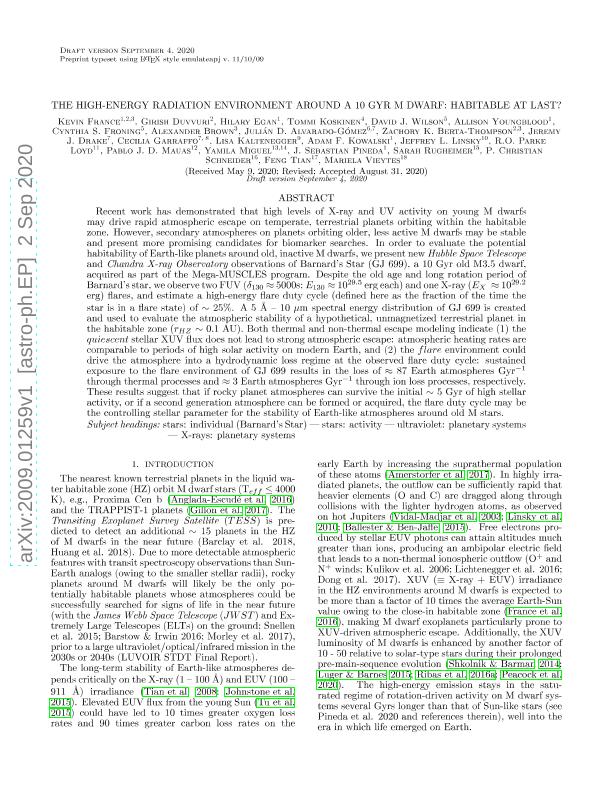Artículo
The High-energy Radiation Environment around a 10 Gyr M Dwarf: Habitable at Last?
France, Kevin; Duvvuri, Girish; Egan, Hilary; Koskinen, Tommi; Wilson, David J.; Youngblood, Allison; Froning, Cynthia S.; Brown, Alexander; Alvarado Gómez, Julián D.; Berta Thompson, Zachory K.; Drake, Jeremy; Garraffo, Cecilia ; Kaltenegger, Lisa; Kowalski, Adam F.; Linsky, Jeffrey L.; Parke Loyd, R. O.; Mauas, Pablo Jacobo David
; Kaltenegger, Lisa; Kowalski, Adam F.; Linsky, Jeffrey L.; Parke Loyd, R. O.; Mauas, Pablo Jacobo David ; Miguel, Yamila
; Miguel, Yamila ; Pineda, J. Sebastian; Rugheimer, Sarah; Schneider, P. Christian; Tian, Feng; Vieytes, Mariela Cristina
; Pineda, J. Sebastian; Rugheimer, Sarah; Schneider, P. Christian; Tian, Feng; Vieytes, Mariela Cristina
 ; Kaltenegger, Lisa; Kowalski, Adam F.; Linsky, Jeffrey L.; Parke Loyd, R. O.; Mauas, Pablo Jacobo David
; Kaltenegger, Lisa; Kowalski, Adam F.; Linsky, Jeffrey L.; Parke Loyd, R. O.; Mauas, Pablo Jacobo David ; Miguel, Yamila
; Miguel, Yamila ; Pineda, J. Sebastian; Rugheimer, Sarah; Schneider, P. Christian; Tian, Feng; Vieytes, Mariela Cristina
; Pineda, J. Sebastian; Rugheimer, Sarah; Schneider, P. Christian; Tian, Feng; Vieytes, Mariela Cristina
Fecha de publicación:
10/2020
Editorial:
IOP Publishing
Revista:
Astronomical Journal
ISSN:
0004-6256
Idioma:
Inglés
Tipo de recurso:
Artículo publicado
Clasificación temática:
Resumen
Recent work has demonstrated that high levels of X-ray and UV activity on young M dwarfs may drive rapid atmospheric escape on temperate, terrestrial planets orbiting within the habitable zone. However, secondary atmospheres on planets orbiting older, less active M dwarfs may be stable and present more promising candidates for biomarker searches. In order to evaluate the potential habitability of Earth-like planets around old, inactive M dwarfs, we present new Hubble Space Telescope and Chandra X-ray Observatory observations of Barnard's Star (GJ 699), a 10 Gyr old M3.5 dwarf, acquired as part of the Mega-MUSCLES program. Despite the old age and long rotation period of Barnard's Star, we observe two FUV (δ 130 ≈ 5000 s; E 130 ≈ 1029.5 erg each) and one X-ray (E X ≈ 1029.2 erg) flares, and we estimate a high-energy flare duty cycle (defined here as the fraction of the time the star is in a flare state) of ∼25%. A publicly available 5 Å to 10 μm spectral energy distribution of GJ 699 is created and used to evaluate the atmospheric stability of a hypothetical, unmagnetized terrestrial planet in the habitable zone (r HZ ∼ 0.1 au). Both thermal and nonthermal escape modeling indicate (1) the quiescent stellar XUV flux does not lead to strong atmospheric escape: atmospheric heating rates are comparable to periods of high solar activity on modern Earth, and (2) the flare environment could drive the atmosphere into a hydrodynamic loss regime at the observed flare duty cycle: sustained exposure to the flare environment of GJ 699 results in the loss of ≈87 Earth atmospheres Gyr-1 through thermal processes and ≈3 Earth atmospheres Gyr-1 through ion loss processes. These results suggest that if rocky planet atmospheres can survive the initial ∼5 Gyr of high stellar activity, or if a second-generation atmosphere can be formed or acquired, the flare duty cycle may be the controlling stellar parameter for the stability of Earth-like atmospheres around old M stars.
Palabras clave:
Actividad Estelar
,
Solar extreme ultraviolet emission
Archivos asociados
Licencia
Identificadores
Colecciones
Articulos(IAFE)
Articulos de INST.DE ASTRONOMIA Y FISICA DEL ESPACIO(I)
Articulos de INST.DE ASTRONOMIA Y FISICA DEL ESPACIO(I)
Citación
France, Kevin; Duvvuri, Girish; Egan, Hilary; Koskinen, Tommi; Wilson, David J.; et al.; The High-energy Radiation Environment around a 10 Gyr M Dwarf: Habitable at Last?; IOP Publishing; Astronomical Journal; 160; 5; 10-2020; 1-15
Compartir
Altmétricas



